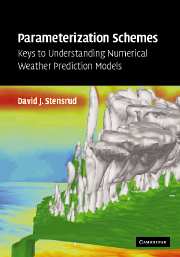Book contents
- Frontmatter
- Contents
- Preface
- List of principal symbols and abbreviations
- 1 Why study parameterization schemes?
- 2 Land surface–atmosphere parameterizations
- 3 Soil–vegetation–atmosphere parameterizations
- 4 Water–atmosphere parameterizations
- 5 Planetary boundary layer and turbulence parameterizations
- 6 Convective parameterizations
- 7 Microphysics parameterizations
- 8 Radiation parameterizations
- 9 Cloud cover and cloudy-sky radiation parameterizations
- 10 Orographic drag parameterizations
- 11 Thoughts on the future
- References
- Index
10 - Orographic drag parameterizations
Published online by Cambridge University Press: 05 September 2013
- Frontmatter
- Contents
- Preface
- List of principal symbols and abbreviations
- 1 Why study parameterization schemes?
- 2 Land surface–atmosphere parameterizations
- 3 Soil–vegetation–atmosphere parameterizations
- 4 Water–atmosphere parameterizations
- 5 Planetary boundary layer and turbulence parameterizations
- 6 Convective parameterizations
- 7 Microphysics parameterizations
- 8 Radiation parameterizations
- 9 Cloud cover and cloudy-sky radiation parameterizations
- 10 Orographic drag parameterizations
- 11 Thoughts on the future
- References
- Index
Summary
Introduction
Mountains are one of the most visually stunning features of the landscape. Created by the collision of tectonic plates and the eruption of volcanoes, and then sculpted by rain and winds, mountains are a source of both inspiration and wonder. The Greek gods were believed to dwell on top of Mount Olympus, while folklore suggests that wise men and women seek mountain tops to find solitude and ponder the fate of the universe. Yet in reality, mountains are obstacles to most forms of transportation and acted as nearly impenetrable barriers to many early human communities. In a similar manner, mountains also influence the atmosphere by acting as obstacles to air flow and their effects are included in parameterization schemes for many numerical weather prediction and climate simulation models.
The flow of water in a fast-moving mountain stream provides a useful analogy to the influences of mountains on the atmosphere. The surface of the water in such a stream is often far from uniform, and clearly shows the influence of submerged obstacles, such as large rocks, that act to perturb the water surface both slightly ahead of and downstream from the obstacles. Mountains act in a similar fashion to perturb the atmospheric flow. This occurs because a stable atmospheric stratification creates buoyancy forces that act to return vertically displaced parcels to their equilibrium levels and because slight ascent often leads to saturation of the atmosphere and cloud formation (Smith 1979).
- Type
- Chapter
- Information
- Parameterization SchemesKeys to Understanding Numerical Weather Prediction Models, pp. 373 - 392Publisher: Cambridge University PressPrint publication year: 2007



